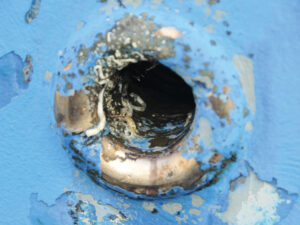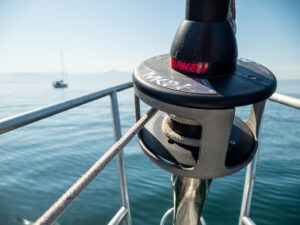
Engine trouble vaporized my bank account and caused an abrupt halt to my push northward up the Intracoastal Waterway aboard my Cheoy Lee Luders Offshore sloop, Traveller. At Mile Marker 403, in Georgetown, South Carolina, Traveller was still a long way away from my home port in Maine. I had a new job about to start in Frankfurt, Germany, and a scheduled flight to get there. With a deadline now looming, the pressing question was: What should I do with the boat? Evenings found me at my laptop at the local McDonald’s, researching boatyards, refilling coffee and weighing my options: I could leave the boat in this South Carolina yard at a high cost (plus pay a yearly property tax!) or have it hauled overland about 400 miles to a less expensive long-term storage yard I’d found on Chesapeake Bay.
Traveller is 36 feet long, and the price difference between the yards was easy to calculate. The new Chesapeake boatyard would be about one-third the cost of the South Carolina yard. But would the trucking fees cancel out any savings?
I continued searching online and, after a couple of dead ends, contacted a boat-transport clearinghouse. They in turn sent my hauling inquiry to Deep Water Transport, a boat-hauling company based in Washington, North Carolina. Deep Water promptly emailed me a quote and asked me to call them. I Skyped them and gave them the boat details.
The rate would be $1,800, which included blocking Traveller on their trailer, transit insurance and all the required permits. The price worked out to a little less than $4.50 a mile. Travelift fees for getting the boat on and off their trailer were my responsibility.
I calculated that $1,800 plus one year of the cheaper storage in the new boatyard would equal one year in South Carolina. Any time spent in storage after that would give me a significant cost savings if I chose the Chesapeake yard. I decided to do it — please send the truck!
The next day, Judith from Deep Water Transport emailed me a contract. They required a $1,500 wire-transferred deposit before they would send the truck. I agreed to their terms, signed the electronic contract and transferred the deposit through a local bank. Straightaway, they acknowledged the receipt of the deposit, and set a pickup date for the following Monday.
I asked Judith for suggestions for getting the boat ready. “Plan ahead, secure or remove anything loose on the boat and have all the boat paperwork in order,” she replied. “That’s the key to a smooth transport.”
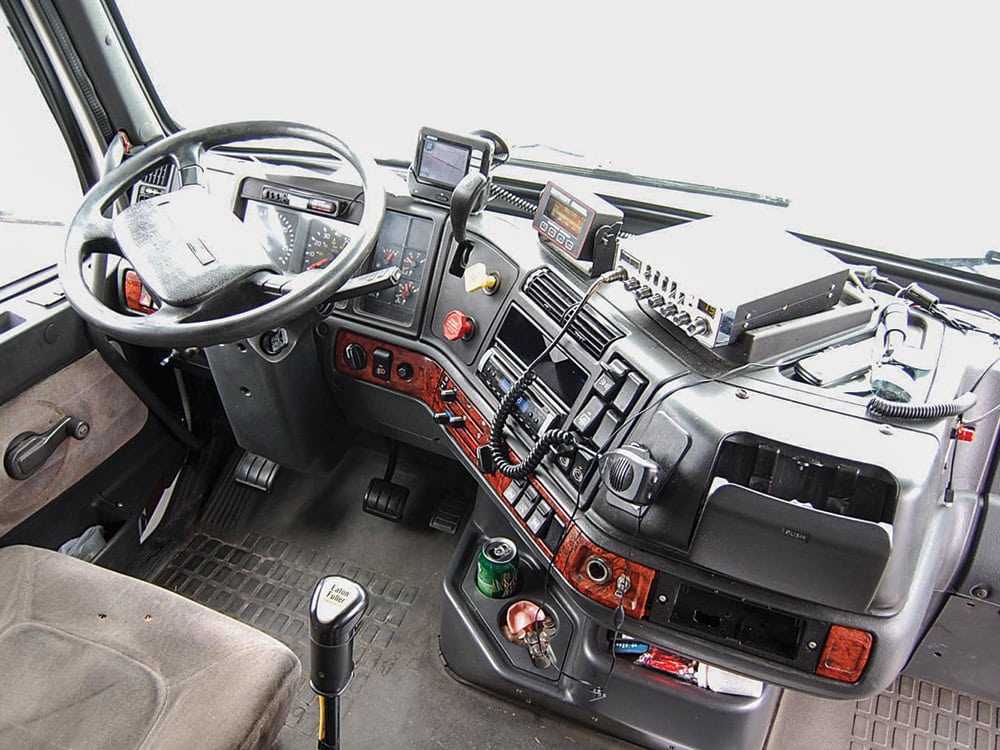
Loading Up
On Monday morning, the massive white cab of an 18-wheeler appeared through the trees and hissed to a stop in the boatyard’s gravel parking lot. I walked over and introduced myself to the driver. Billy Ray was a small, burly man in shorts and heavy shoes. He slid down from the high cab, brushed himself off and said, “I’m hongry! Where’s a good place to eat around here?” I suggested an all-you-can-eat buffet down the road. He unhitched the trailer. The tide had just turned, and haulout wasn’t for a few hours. “C’mon, let’s go!” he said, so we climbed into the cool AC of the big white truck and headed to the diner.
When the tide was high, the boat was hauled, and the yard crew made it clear that they wanted Traveller off the Travelift as soon as possible. While the bottom was being pressure washed, the Travelift driver looped a sling under the mast spreaders. Another helper and I disconnected the shrouds and stays. While the crew finished the bottom and lowered the mast onto sawhorses, I turned my attention to arranging the blocking on the trailer.
Billy Ray had brought an assortment of wooden blocks, and with a cold drink in hand, he pointed along the backbone of the trailer. “We’ll need a couple here, and there and there.” I placed the blocks where he pointed, then looked up to see Traveller suspended in midair and heading my way. Traveller was lowered onto the trailer, and the hydraulic arms were adjusted, padded and readjusted. Next, we set up and padded the steel crossbeams for the mast.
Back at the mast, Billy Ray scrutinized the lashings on the stays and shrouds. “Need lots of ropes there, boys. It’s like a hurricane out there on that interstate: 60-mile-an-hour wind. We don’t want nothin’ shaking loose.” It took six of us to carry the trussed-up rig to the trailer.
With the mast secured, Billy Ray leaned a ladder against the hull and inspected the cleared deck. The anchor and chain had been unshackled and stowed securely below. Cowls had been unscrewed and stowed; missing deck plates had been sealed with duct tape. All lines had been coiled and stowed in the cockpit lockers, and small padlocks secured the lazarette seats so they wouldn’t blow open.
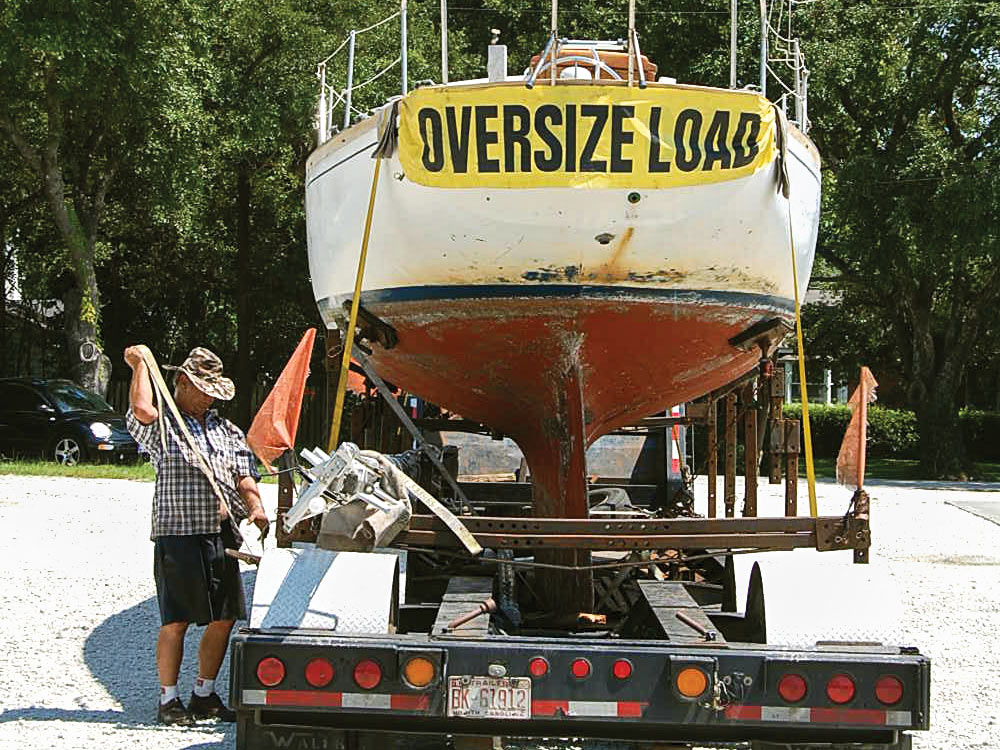
The Windex wind indicator had been a fragile piece to stow. Eventually, I’d settled on a heavy cardboard box, lined it with T-shirts and stored the box in a locking cabinet.
It was surprising just how many small blocks and bits of line were secured to the stanchions and lifelines, but they all had to be removed, labeled and boxed. The few electronics I use had been removed, rolled up in towels and carefully stowed in deep cabin drawers. Sails had been unhanked and bagged. The dodger and bimini frames were disassembled and stored below, along with their canvas. The inflatable dinghy had been deflated, rolled and stowed in a bunk.
Four large plastic bins I’d purchased from the local DIY store were strong and cheap — perfect for packing all the loose items in the cabin. They filled up quickly. I snapped on their covers, shoved them forward onto the V-berth and wedged them in with sail bags.
The big water tank below the cabin sole was emptied. Hatches and opening portholes had been double-checked and dogged down. Seacocks were closed. The steering wheel was lashed amidships. The boom and the spinnaker pole were lashed to cushions on the cabin sole.
Billy Ray continued his inspection, pushing things, prodding others and rattling all the drawers. When nothing moved, he pronounced us roadworthy.
It must have been 103 degrees when we finally left the boatyard, and within 15 minutes Billy Ray had gotten us stuck in a tree. He drove the rig forward then back, struggling to get out from under a low-hanging branch, but it was firmly stuck in Traveller‘s stainless-steel pulpit. I sweated up to the foredeck and tried to push the branch away.
“Let’s haul ass,” Billy Ray yelled from the cab. “Don’t you worry, she’ll break off.” I wasn’t quite sure if he meant the branch or the pulpit.
The boat lurched, there was a snap and we were free.
Thankfully, it was the branch that had snapped, so in a puff of black smoke and a grinding of gears we headed north.
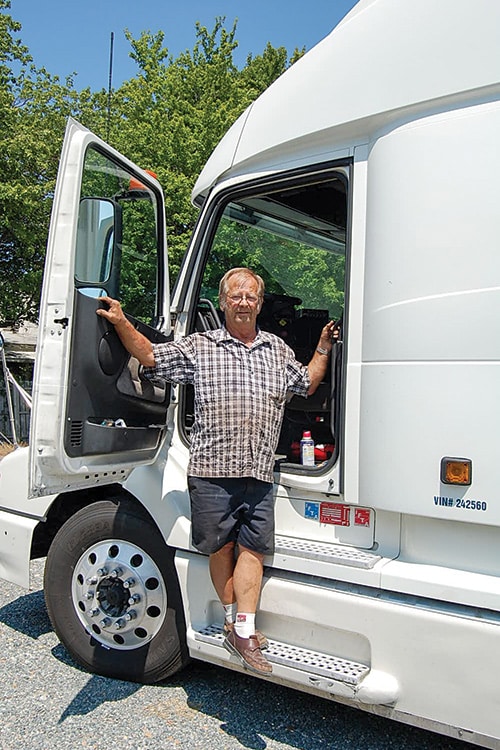
Wide Load
With a beam of just over 10 feet, Traveller exceeded the maximum normal trailer load width of 81⁄2 feet. This meant the transport required wide-load permits and put us into an entirely different hauling category. We were required to stop at sunset and could not resume travel until sunrise. We had to park in designated wide-load areas. The boat is a little leggy too, with a draft a bit over 5 feet, so we had to be aware of the height clearance of every underpass on every road, in every town, in every state we touched. Luckily, the specifications were all listed in books.
Billy Ray had an assortment of almanacs for sunrise and sunset, guidebooks with overpass heights for all the states and highways, even Rules of the Road for Wide Load Hauling. Riding shotgun, I helped with the navigation and looked up whatever reference was required for each of the three states we were driving through.
As the sun set (and I checked the exact time in the almanac), he pulled the big rig into a designated wide-load parking lot that was next to a Hardee’s restaurant. The evening air was hot and humid. I would be sleeping in my usual saloon bunk on Traveller, and it was hot down there. I wanted to hook up a little air conditioner that I usually wedged in the companionway hatch.
Not a problem. Billy Ray opened up a side panel on the truck and unrolled a long extension cord. He plugged the other end into his onboard generator — another land-cruising accessory.
We arrived at the new boatyard the next day, and their Travelift hoisted Traveller off the trailer and onto new blocking and jack stands.
Billy Ray and I had a crabcake lunch and then it was time for him to head back to North Carolina. We shook hands and waved farewell. The big rig rumbled off down another blue highway as I walked back to Traveller.
Everything looked fine. The new boatyard crew was friendly and helpful.
Road hauling had been money well spent.
Pre-Hauling Checklist
Remove all personal items from the boat.
All fuel must be removed from the boat, and because of weight and the possibility of leakage, as much water as possible should also be removed.
Secure all hatches and doors; lock them where possible.
All canvas covers, loose cushions, grills, deck chairs, hatch doors, etc. must be removed or secured so they do not bang around below during transport.
Electronics, including radios, radar, AIS, GPS, etc., should either be shipped separately or securely stowed in the cabin and locked up.
Masts must be derigged. All stays and spreaders should be bound to the rig or, better yet, be removed. The strongest side of the mast should be left clear to rest on the trailer. Wrapping masts, particularly painted ones, with pieces of carpet is an option.
Rudders that can turn or move in the wind should be removed, or well secured.
Outboard motors should be removed, or raised and locked.
It is very important to remember that interstate highway speeds are equal to hurricane-force winds. Add driving rain and you can see why your boat must be ready for storm conditions.


